Small Ideas Making a big Difference in Digital Marketing
For better or for worse, the Internet has had a major “democratizing” effect on commerce. Virtually everyone has access to the same information. And virtually everyone can woo potential clients and customers in the same way.
On any given morning, for example, your email in-box probably has a marketing newsletter from a Fortune 500 company and a one-person startup waiting for you. They both look the same. They both moved through the Internet at the same speed. But, over time, some web-based companies will be successful, some will fail.
Of course, in many cases companies will fail because they offer a product or service that people didn’t want, or weren’t yet ready for. However, in some cases the difference between online commercial success and failure is determined by who consistently does the little things right. Here are two of those smaller points that, when done right, can help put your business in the winner’s circle.
Micro-decisions
One of the most important principles to understand is the concept of micro-decisions. I want to frame this discussion with the understanding that when you do business via the Internet, it’s crucial that you create a trusting relationship with your prospects. That is accomplished by leading your prospects to make a series of micro-decisions, and this principle can be applied in many different settings.
Let me start with one that you might not have considered. You probably understand the importance of building your email list, but have you thought about applying the concept of micro-decisions to increase your signup rate? Most digital marketers will present something like this popup:

That’s a “do-or-die” presentation. You’re forcing your prospect to make an immediate and irrevocable decision; you’re pushing your prospect into a corner. Although it may seem anti-intuitive at first, it’s often better to add a step to that popup sequence and start with something like this:

And then when a prospect answers “Yes,” follow it up with the signup form:

With this sequence, you’ve started to establish a relationship. You’ve asked a question that is easy to answer and leads to a nonthreatening micro-decision.
Strategy for Your Sales Funnel
You can carry the same strategy throughout your sales funnel. Smaller decisions to receive free content and lower-priced items build the relationship, and if you put quality materials into the hands of your prospects, they will be willing to make the larger decisions when you present them. This is why freemiums can be such a great marketing tool.
Here’s the trap some digital marketers fall into: They are so excited about and sold on their products that they think everyone will share their excitement. You need to remember that with each new prospect that finds your website, you’re starting from ground zero. They don’t share your excitement, you have to build trust and introduce them to your products and services in a way that leads them to share your excitement.
Email Subject Lines
While we are using micro-decisions throughout your digital marketing and sales process, we spent a lot of time on the email list signup question above. So let’s stick with that topic and offer some simple advice.
You can find all kinds of tricks and hacks that supposedly deliver high open rates, but the best research we’ve seen comes from MailChimp. They looked at thousands of emails and categorized the best open rates. Among their top 20 subject lines, 17 included the company name of the sender.
The number one subject line was “[Company Name] Sales and Marketing Newsletter.” Other variations included simple subjects such as “[Company Name] Newsletter February 2006” and “Invitation from [Company Name].”
Why do you think these unglamorous subject lines got such high open rates? The answer is simple: The people receiving the emails trusted [Company Name] to provide high quality information it its email newsletters!
Lesson: If you have created a great relationship, you don’t have to trick people with deceptive subject lines!
And how do you create that great relationship? See tip number one above: Micro-decisions…
